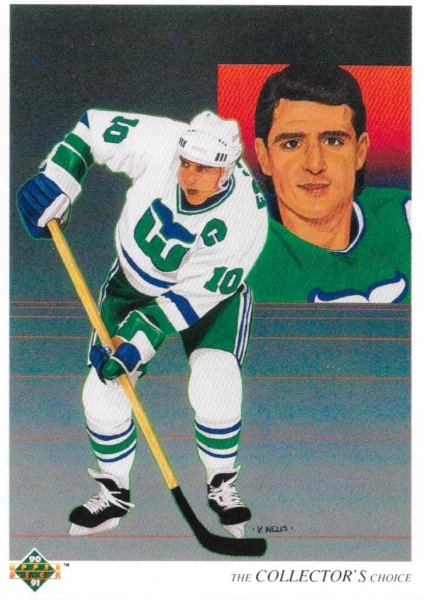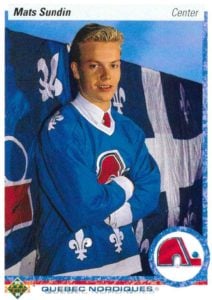Game Changer: 30th Anniversary of Upper Deck Hockey Slips By

Contents
Sometimes anniversaries are celebrated, and sometimes they come and go.
This year, a big one came and went without much fanfare at all. This was the 30th anniversary of the 1990-91 hockey card season. That was the season that the hockey card market took off. It was also the year that Upper Deck released its first set of NHL hockey cards, one that changed collecting and the way business was done in the industry forever.
Many old enough to remember the excitement of that hockey season will know that the hobby has never quite been the same. I was a lifelong collector in my mid-20s, and I will never forget tearing the cellophane wrapper off the box and ripping open the first pack.
It was 1990-91. Upper Deck’s first hockey offering was highly anticipated. Barrhaven, Ontario, which had a population of about 20,000 people at the time, had three hobby shops. They were all bustling with activity as the hobby was at a peak we will likely never see again. Sure, the hobby is growing and it is coming back in a strong way, but the excitement of Upper Deck entering the market in hockey, football and basketball, and their pre-production sell-out of their 1990 baseball cards, took collecting mainstream. There were more shops, more shows, more people at shows, and more excitement around the hobby in the early 1990s than ever before.
My family was in the newspaper business. My father owned a chain of small town weekly newspapers and a printing press. I went to Carleton University in Ottawa, which was Canada’s largest journalism school. Upon graduating, I went to work with my father, and we opened up a couple of new newspapers, including one in Barrhaven in 1990. I was also writing for a fledgling sports card publication called Canadian Sportscard Collector. I was often referred to as “the Canadian Beckett,” even though we made every effort to be different than Beckett and we offered a completely different product. Looking back, we may have been more like a Canadian Tuff Stuff.
My co-worker in the newsroom was also a big collector. We used to go to Mike’s Sports Cards, down the road from our office, at least two or three times a week. Mike put aside two boxes of 1990-91 Upper Deck Hockey for each of us to buy. After work, we went to pick them up, and then we drove to McDonald’s. We ordered McPizza – how 1990-91 is that? – and opened our cards over dinner.
The first thing that struck us was the weight of the cards. We were excited and surprised that the box of Upper Deck Hockey was the heaviest box of cards we had ever held in our hands.

Once we started getting into packs, the photography and the vivid coloring of the cards really caught our attention. The hot colors – the reds, yellows and oranges – really popped off the cards. We could tell the blues were enhanced. Two years later, I learned the Quark Xpress program and completely understood how Upper Deck color corrected every card.

Upper Deck’s photography really stood out that year because we had never seen anything like that on a hockey card. Great action photos, color enhanced and well-cropped, printed on a premium bright white stock and finished with aqueous coating was the recipe for the perfect card.

We had all grown up collecting O-Pee-Chee hockey cards, which were a Canadian version of the Topps hockey cards. Their cards were nothing like the cards Upper Deck put out that year. Looking back, within a couple of years, Pinnacle Hockey, Topps Stadium Club and Fleer Ultra had probably surpassed Upper Deck in photo and reproduction quality. But Upper Deck was Upper Deck. They were Coke, and the other hockey card companies were a collective Pepsi.
As we look back at the 1990-91 Upper Deck Hockey card set 30 years later, there are a few things that stand out.
David Volek vs Ken Griffey Jr.
The first thing is card number 1 on the checklist. When I worked at Pinnacle, I met Tom Geideman, who was a teenager working for Upper Deck when they released their inaugural baseball card set the previous year. Tom told me the story of how he was the one who argued successfully to make Ken Griffey Jr. the first card in the set. It was a brilliant idea. The first card, and card 100, were always superstars in Topps sets. Going with a future superstar would give Upper Deck a card that would become their signature card of that first offering. Tom went on to start a company called SAGE.
But in their first hockey card set, card number 1 was not Wayne Gretzky. He was card number 54. It was not Mario Lemieux or Patrick Roy. It was not a prospect card of Pavel Bure or Jaromir Jagr. It was David Volek, a Czech winger who played for the New York Islanders. Volek scored 95 goals in six seasons with the Islanders.

Another overlooked fact is that this set was released before insert cards really took off. There were inserted holograms in this set, featuring Gretzky, Brett Hull, Mark Messier and Steve Yzerman. The quality of the holograms is very poor compared to where the technology was five years later. The cards could be used as stickers or kept in their card version. But the hologram inserts never really took off because they were so difficult to see.

Gretzky, meanwhile, quickly became the focal point of Upper Deck’s hockey division. He is still included in trading card sets, and he is a key driver for Upper Deck Authentic’s memorabilia line. Although he has not played in two decades, and no matter how good Connor McDavid, Sidney Crosby, Nathan MacKinnon and Auston Matthews are, the demand for Gretzky cards and collectibles still drives the hockey market.

There was a subset called Collector’s Choice, which featured 24 cards of NHL stars done using artwork instead of photography. Perhaps Upper Deck was trying to cash in on the frenzy of that time frame over Donruss Diamond Kings baseball inserts. Either way, it didn’t work. This is a set driven by photography, so why go away from it and use mediocre art? Collector’s Choice was a strong name, however, and it quickly became the company’s entry level brand in all sports.
Young Guns, World Juniors
The high series, cards 451-600, was a real treasure for collectors. It featured two subsets that would become the backbone of Upper Deck hockey cards. The Team Canada World Juniors subset was all rookie cards of NHL prospects, and featured players like Felix Potvin, Pat Falloon, Patrice Brisebois, Scott Niedermayer, Scott Thornton, Brad May and several others that were soon to be in the NHL. The World Junior Tournament was in its infancy as far as its popularity goes. In Canada, TSN had just started showcasing the tournament, which begins on Boxing Day (Dec. 26) every year. The popularity of Upper Deck hockey cards and the inclusion of this subset made collectors around the world pay attention to the tournament.

Canadians were not the only juniors in the set. Russian star Pavel Bure appears in the set as the captain of his junior team. He appears in the Young Guns rookie card subset, which has remained a focal point for Upper Deck Hockey and is still the most important subset in the hockey card market to this day.
Another element to the set that you no longer see is cards of draft picks. Do you remember when the players briefly went on strike in April, 1992? There were a number of issues that led to the strike, but the main issue was royalty over hockey card royalty revenues. The royalties, at that time, were $16 million annually. The pie was split more evenly, and one of the things that came out of those negotiations was that players would not be included in NHL card sets until they had played their first NHL game. That put an end to the draft pick cards in NHL sets. The list of draft pick rookie cards in the 1990-91 Upper Deck set included Owen Nolan, Jaromir Jagr, Mats Sundin and Mike Ricci, among others.

There was an exception granted for players in the World Junior Hockey Tournament. As a result, Upper Deck continued to produce Team Canada World Junior subsets. This license gave them an advantage over companies like Pinnacle, Fleer and Pacific. When I worked at Pinnacle, I used to rant to my higher ups about the unfair advantage this gave to Upper Deck. My concerns were politely dismissed, either because my vision of what constitutes a possible anti-trust lawsuit was inaccurate, or there weren’t enough dollars in the big picture to go through the legal process of filing a suit that might blow up the relationship with our licensors. Or, the other possibility was that Pinnacle was on the onramp, accelerating onto the Chapter 11 highway. So did it even matter?
TSN was broadcasting all World Junior Tournament games by this point. In Canada, there was an intersection of the surge in interest over this tournament and the surge of buying hockey rookie cards on speculation.
Trial and error
But as strong as the rookie content is in the 1990-91 Upper Deck high number series, not everything worked. The Heroes of the NHL subset was not well received, despite featuring a checklist of former superstars. The problem was that the photography used was current. Collectors didn’t want to see retired stars like Phil Esposito and Bobby Clarke as older men in generic Heroes of the NHL uniforms. If Upper Deck had sourced photos of those players from their playing days, perhaps those cards would have been looked upon as more than a set filler.

From a business standpoint, 1990-91 Upper Deck Hockey turned the hobby upside down with their French language version of the set. At the time of its release, the French boxes and packs were hard to find, even in Ottawa, and the perception fueled by rumors was that it was extremely rare compared to the English cards. Eventually, the hobby caught on that the French cards were not rare, but not until la lot of distributors and dealers made a lot of money. Using distribution channels to leak information about the scarcity of certain products became a common practice in the hobby of the next few years. In particular, think of 1992 Bowman Baseball. Today, those French boxes can still be had for $75-$100.
The 1990-91 Upper Deck hockey set is still easy to find at a good price. It is loaded with rookies, great photography, and there is even a card paying tribute to Frank Zamboni, who invented the ice resurfacing machine.

This set might not be an investment for a collector, but it is certainly one worth having in a binder on your bookshelf for the significance it had in changing the hockey card industry. Upper Deck wasn’t the only card company that entered the market that year – Score and Pro Set also joined the hockey market – but 30 years later, they are the ones that endured the ups and downs of what is once again a growing market.





